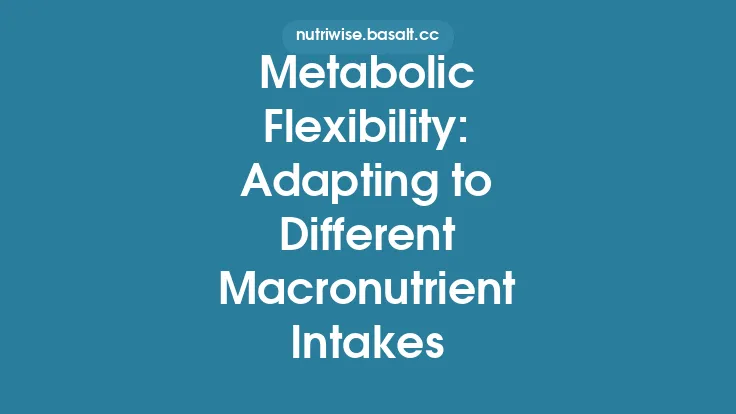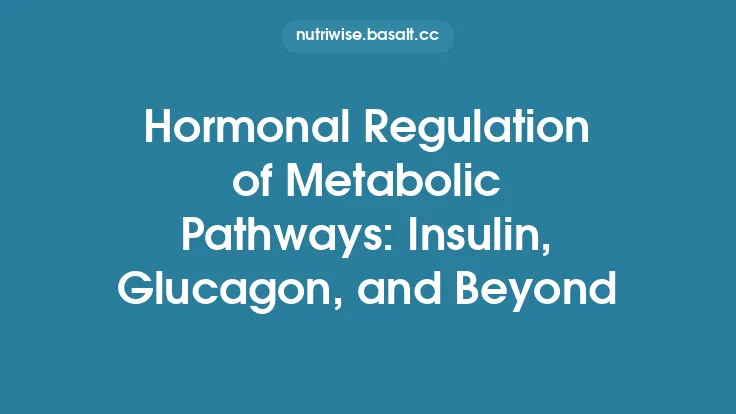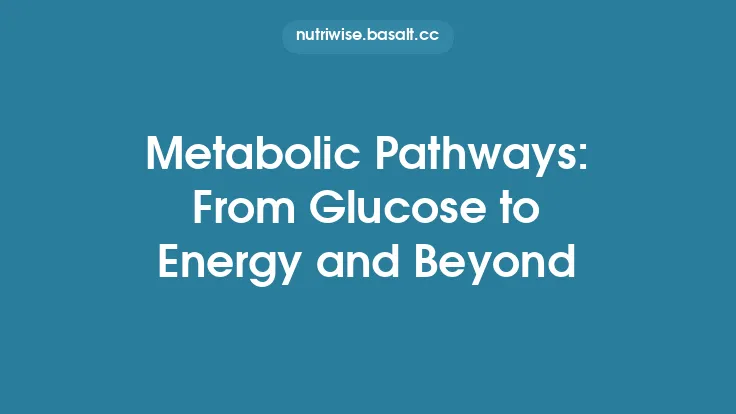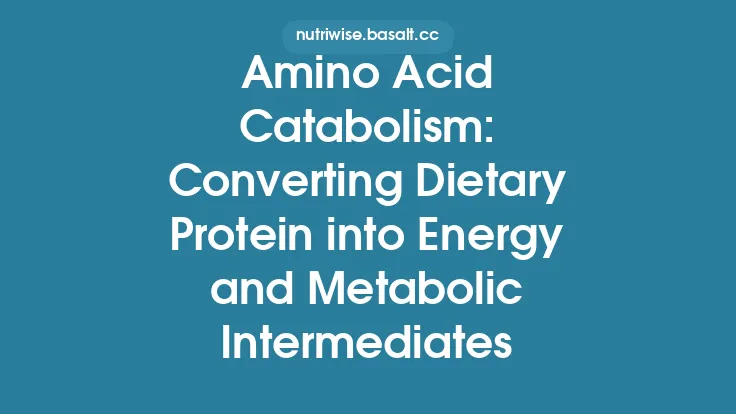Metabolic flexibility refers to the body’s ability to adjust its fuel oxidation pathways in response to changes in nutrient availability, energy demand, and hormonal cues. Rather than being locked into a single substrate, such as glucose or fatty acids, a metabolically flexible system can seamlessly shift between glucose, fatty acids, and ketone bodies, ensuring that cells receive the most efficient source of energy under any given circumstance. This adaptability is a hallmark of healthy physiology and underpins many of the body’s responses to feeding, fasting, exercise, and environmental stressors.
What Is Metabolic Flexibility?
Metabolic flexibility is the dynamic capacity of tissues—most notably skeletal muscle, heart, and liver—to modulate the relative contribution of carbohydrate, lipid, and ketone oxidation to meet ATP requirements. In a flexible state, the organism can:
- Prioritize glucose when carbohydrate intake is high or during high‑intensity activity that demands rapid ATP generation.
- Switch to fatty acids during prolonged, low‑intensity activity or overnight fasting, when plasma glucose and insulin levels fall.
- Utilize ketone bodies during extended periods of carbohydrate restriction or prolonged fasting, when hepatic ketogenesis supplies an alternative, brain‑compatible fuel.
A loss of this flexibility—often termed “metabolic inflexibility”—is associated with insulin resistance, type 2 diabetes, obesity, and reduced exercise performance.
Key Enzymatic Switches Governing Substrate Preference
While the core catabolic pathways (glycolysis, β‑oxidation, ketolysis) are well‑characterized, metabolic flexibility hinges on a few pivotal control points that act as molecular “switches”:
| Switch | Primary Enzyme(s) | Direction of Shift | Functional Impact |
|---|---|---|---|
| Pyruvate Dehydrogenase (PDH) Complex | PDH, PDH kinase (PDK), PDH phosphatase | Glucose → Fat oxidation (PDK activation) | Phosphorylation by PDK inhibits PDH, limiting conversion of pyruvate to acetyl‑CoA, thereby favoring fatty‑acid oxidation. |
| Carnitine Palmitoyltransferase 1 (CPT‑1) | CPT‑1, malonyl‑CoA | Fat → Glucose oxidation (malonyl‑CoA inhibition) | Elevated malonyl‑CoA (produced when carbohydrate is abundant) blocks CPT‑1, reducing mitochondrial fatty‑acid entry. |
| Acetyl‑CoA Carboxylase (ACC) | ACC1 (lipogenesis), ACC2 (fat oxidation) | Glucose → Fat storage (ACC activation) | ACC generates malonyl‑CoA, linking carbohydrate excess to inhibition of fatty‑acid oxidation. |
| Ketolytic Enzyme (SCOT) | Succinyl‑CoA:3‑oxoacid CoA‑transferase (SCOT) | Ketone → Glucose oxidation (SCOT up‑regulation) | SCOT enables peripheral tissues to convert β‑hydroxybutyrate and acetoacetate into acetyl‑CoA for the TCA cycle. |
The activity of these enzymes is modulated by reversible phosphorylation, allosteric effectors (e.g., acetyl‑CoA, NADH/NAD⁺ ratios), and substrate availability, creating a rapid feedback system that toggles between fuel sources.
Cellular and Tissue‑Level Coordination
Metabolic flexibility is not a property of isolated cells; it emerges from coordinated communication among organs:
- Skeletal Muscle: The largest consumer of glucose and fatty acids during activity. Muscle fibers express isoforms of CPT‑1 and PDH that respond to intracellular energy status (AMP/ATP ratio) and circulating metabolites.
- Liver: Acts as a hub, storing excess glucose as glycogen, converting surplus carbohydrate to fatty acids (de novo lipogenesis), and producing ketone bodies during carbohydrate scarcity.
- Adipose Tissue: Releases free fatty acids (FFAs) via lipolysis when insulin is low, providing substrate for peripheral oxidation. It also secretes adipokines that influence muscle and liver metabolism.
- Heart: Highly oxidative, it preferentially oxidizes fatty acids at rest but can shift to glucose or ketones during stress or ischemia.
Cross‑talk occurs through metabolite flux (e.g., plasma FFAs, glucose, lactate) and signaling molecules (e.g., adipokines, myokines). The net effect is a system that matches fuel supply with demand across the whole organism.
Physiological Triggers: Feeding, Fasting, and Exercise
| Condition | Dominant Fuel | Primary Regulatory Signals |
|---|---|---|
| Post‑prandial (high‑carb meal) | Glucose | ↑Insulin → ↑PDH activity, ↑ACC → ↑malonyl‑CoA → CPT‑1 inhibition |
| Overnight fast (≈12 h) | Fatty acids | ↓Insulin, ↑glucagon → ↓malonyl‑CoA → CPT‑1 activation, ↑PDK activity |
| Prolonged fast (>24 h) or ketogenic diet | Ketone bodies | ↑hepatic HMG‑CoA synthase → ↑β‑hydroxybutyrate, ↑SCOT in peripheral tissues |
| Low‑intensity endurance exercise | Fatty acids | ↑AMP/ATP ratio → AMPK activation → ACC inhibition → ↓malonyl‑CoA |
| High‑intensity interval training | Glucose | ↑Catecholamines → ↑glycogenolysis, ↑PDH activity, transient inhibition of fatty‑acid oxidation |
These triggers illustrate how the same enzymatic switches are toggled in opposite directions depending on the metabolic context, allowing rapid adaptation without the need for new protein synthesis.
Nutrient Availability and Transport Mechanisms
Fuel switching also depends on the capacity of transporters to deliver substrates to mitochondria:
- Glucose Transporters (GLUTs) – GLUT4 translocates to the plasma membrane in muscle and adipose tissue in response to insulin and contraction, dictating glucose uptake.
- Fatty‑Acid Transport Proteins (FATPs, CD36) – Facilitate cellular entry of FFAs; their activity is up‑regulated during fasting and exercise.
- Monocarboxylate Transporters (MCTs) – Mediate lactate and ketone exchange across membranes, crucial for shuttling ketone bodies from liver to peripheral tissues.
Alterations in transporter expression or trafficking can blunt flexibility. For example, reduced GLUT4 translocation is a hallmark of insulin‑resistant muscle, limiting glucose oxidation even when carbohydrate is abundant.
Molecular Signals Beyond Classic Hormones
While insulin and glucagon are central, several non‑classical signals fine‑tune substrate preference:
- AMP‑Activated Protein Kinase (AMPK) – Senses cellular energy deficit (high AMP/ATP) and phosphorylates ACC, lowering malonyl‑CoA and promoting fatty‑acid entry into mitochondria.
- Sirtuins (SIRT1, SIRT3) – NAD⁺‑dependent deacetylases that modify PDH, CPT‑1, and enzymes of ketogenesis, linking cellular redox state to fuel selection.
- Fibroblast Growth Factor 21 (FGF21) – Produced by liver during fasting; enhances fatty‑acid oxidation and ketogenesis, and improves peripheral ketone utilization.
- Myokines (e.g., irisin, IL‑6) – Released by contracting muscle; can increase mitochondrial biogenesis and fatty‑acid oxidation capacity.
These pathways provide layers of regulation that allow metabolic flexibility to respond to subtle changes in nutrient and energy status, independent of overt hormonal swings.
Adaptations in Different Populations
- Endurance Athletes – Exhibit heightened mitochondrial density, increased oxidative enzyme capacity, and a lower respiratory exchange ratio (RER) during submaximal exercise, reflecting a bias toward fat oxidation and rapid switching to carbohydrate when intensity rises.
- Individuals on Low‑Carb/Ketogenic Diets – Show up‑regulated hepatic ketogenesis, increased expression of SCOT and MCTs in brain and muscle, and a reduced reliance on glucose, illustrating an adaptive shift toward ketone utilization.
- Aging Population – Often displays reduced AMPK activity, impaired mitochondrial function, and diminished GLUT4 translocation, contributing to a loss of flexibility and a propensity for insulin resistance.
- Obese/Metabolically Unhealthy Individuals – Frequently present with chronic low‑grade inflammation that interferes with insulin signaling, leading to persistent fatty‑acid oxidation even in the fed state (metabolic inflexibility).
Understanding these phenotypic variations helps tailor interventions aimed at restoring or enhancing flexibility.
Implications for Health and Disease
- Insulin Sensitivity – Flexible individuals can suppress fatty‑acid oxidation in the fed state, preventing lipid accumulation in muscle and liver, thereby preserving insulin signaling.
- Weight Management – Efficient switching to fat oxidation during caloric deficit supports adipose tissue mobilization, while the ability to re‑engage carbohydrate oxidation prevents excessive ketone buildup.
- Cardiovascular Health – A heart that can oxidize ketones during ischemia may sustain ATP production when glucose delivery is compromised.
- Neurodegenerative Disorders – Ketone bodies cross the blood‑brain barrier and can serve as an alternative energy source for neurons with impaired glucose metabolism, a principle explored in therapeutic ketogenic protocols for epilepsy and Alzheimer’s disease.
Conversely, chronic metabolic inflexibility contributes to ectopic lipid deposition, oxidative stress, and impaired cellular signaling, accelerating disease progression.
Strategies to Enhance Metabolic Flexibility
- Periodized Nutrition
- Alternate carbohydrate‑rich and low‑carbohydrate days (e.g., “carb cycling”) to train the body to oxidize both fuels efficiently.
- Incorporate fasting windows (12–16 h) to stimulate fatty‑acid oxidation and modest ketogenesis.
- Exercise Prescription
- Combine steady‑state aerobic sessions (promote fat oxidation) with high‑intensity interval training (preserve glucose oxidation capacity).
- Include resistance training to increase muscle mass, which expands the reservoir for glucose uptake.
- Targeted Supplementation
- Omega‑3 fatty acids – Enhance membrane fluidity and CPT‑1 activity.
- Berberine or metformin – Activate AMPK, lowering malonyl‑CoA and favoring fatty‑acid oxidation.
- Exogenous ketone esters – Acclimate peripheral tissues to ketone utilization without prolonged fasting.
- Lifestyle Modifications
- Prioritize sleep and stress management; chronic cortisol elevation can blunt insulin sensitivity and impair substrate switching.
- Maintain adequate hydration and electrolyte balance, especially during low‑carb or fasting periods, to support efficient mitochondrial function.
- Monitoring Tools
- Respiratory Exchange Ratio (RER) – Provides a real‑time snapshot of substrate utilization during exercise or rest.
- Blood Metabolite Panels – Track fasting glucose, insulin, free fatty acids, and β‑hydroxybutyrate to gauge flexibility trends.
Future Directions in Research
- Omics‑Driven Mapping – Integrating transcriptomics, proteomics, and metabolomics to delineate individual variability in the expression of key switches (PDK, CPT‑1 isoforms) and their response to interventions.
- Microbiome Interactions – Investigating how gut‑derived metabolites (short‑chain fatty acids, bile acids) influence peripheral fuel selection via signaling pathways distinct from classic hormones.
- Precision Nutrition Algorithms – Developing predictive models that recommend personalized macronutrient timing based on genetic markers of metabolic flexibility.
- Therapeutic Modulators of Sirtuins and AMPK – Designing small molecules that selectively enhance the activity of these sensors without off‑target effects, aiming to restore flexibility in metabolic disease.
Continued exploration of these avenues promises to refine our ability to harness metabolic flexibility for health optimization, athletic performance, and disease mitigation.





